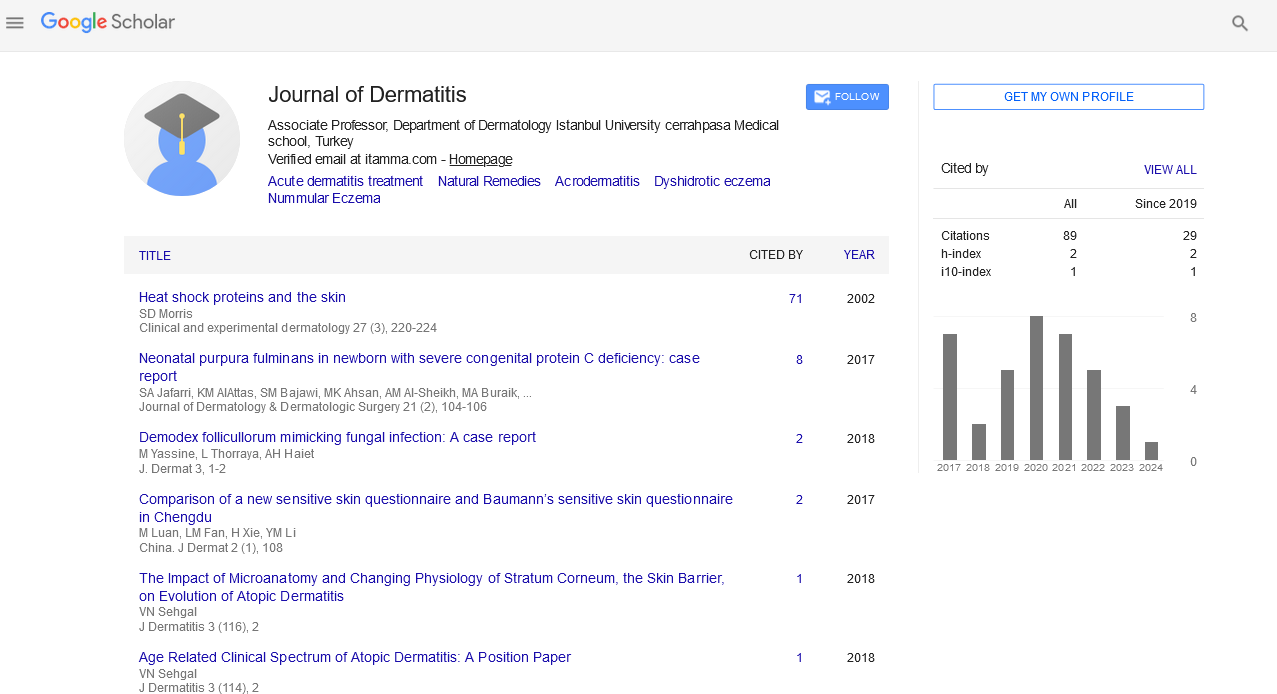Indexed In
- RefSeek
- Hamdard University
- EBSCO A-Z
- Euro Pub
- Google Scholar
Useful Links
Share This Page
Journal Flyer

Open Access Journals
- Agri and Aquaculture
- Biochemistry
- Bioinformatics & Systems Biology
- Business & Management
- Chemistry
- Clinical Sciences
- Engineering
- Food & Nutrition
- General Science
- Genetics & Molecular Biology
- Immunology & Microbiology
- Medical Sciences
- Neuroscience & Psychology
- Nursing & Health Care
- Pharmaceutical Sciences
Opinion Article - (2023) Volume 8, Issue 1
Types of Eczema Herpeticum and their Treatment and Complications
Garcia-Mouronte Rico*Received: 02-Jan-2023, Manuscript No. JOD-23-19859; Editor assigned: 04-Jan-2023, Pre QC No. JOD-23-19859 (PQ); Reviewed: 18-Jan-2023, QC No. JOD-23-19859; Revised: 25-Jan-2023, Manuscript No. JOD-23-19859 (R); Published: 01-Feb-2023, DOI: 10.35248/2684-1436.23.08.173
Description
A widespread viral illness known as eczema herpeticum is characterized by fever and clusters of painful blisters or punchedout erosions on the skin. The blisters burst and ooze pus. Some cases of eczema herpeticum progress to invasive lesions of bone and soft tissue. Severe herpetic eczema may occur if the eczema causes skin damage (accumulation of bacterial pus), or if the disease is transferred to a caregiver’s hand. Extreme cases of eczema herpeticum may spread throughout the body and lead to death.
Top 3 types of eczema herpeticum
In clinical medicine, Eczema Herpeticum is divided into 3 types: dermatophytosis, erosive skin necrosis, and septicaemia. Consider the subtypes of eczema, which are commonly observed in secondary conditions of eczema. Differential diagnoses are provided by the American College of Rheumatology and the International Eczema Association. Dermatophytosis is an infection of the skin that affects the cornea, conjunctiva, nasal lining, and layers of skin surrounding the throat. This leads to erosions and blisters with redness and possible formation of red rash-like spots. The pigmented stroma is blistered and may resemble plaque. Eczema erosive skin necrosis occurs in adults and children. It occurs where the protective layer of the skin of the nose, eyes, throat, mouth, and genital region (molluscum) has been damaged. The skin turns dry and cracked, and lesions develop. These may cause the nose and lips to be infected. Severe cases of septicaemia have the potential to cause damage to the bone or blood vessels. The lesions are white and distinct with blistering and reddening. They contain pus, which is discoloured due to formation of eosinophilic “blackheads”.
Treatment of eczema herpeticum
There is no specific cure for eczema herpeticum. But doctor may prescribe oral antibiotics, oral steroids, oral immunoglobulins, intravenous immunoglobulins, intravenous immunoglobulins with steroids, and topical steroid creams. In addition, topical creams with different types of anti-inflammatory agents may help. Oral antibiotics may also be used for children. Sonsuk Sein is a health advisor at Indus Health Net, a leading healthcare provider, and the director of Institute of Integrative Health Services, East Central Healthcare Organization and Singapore. Eczema herpeticum is a severe cutaneous vesicular eruption that develops from a pre-existing skin condition, typically atopic dermatitis. It is also known as a kind of Kaposi varicelliform eruption caused by viral infection, typically with the Herpes Simplex Virus (HSV). Shearing causes ulceration and infection in the connective tissue and surrounding tissues. It is sometimes associated with enteral disulfide-binding protein and antibodies.
Impact of eczema herpeticum
Herpes simplex virus causes eczema, and in the context of herpes simplex virus dermatitis, the transmission from skin to skin is important. Because of eczema, lesions with high viral loads are more likely to cause more severe eczema lesions (eczema herpeticum). This creates a vicious cycle of eczema outbreaks and escalating eczema severity. Thus, it is often better to manage eczema with cold-encapsulated vaccines.
Complications of eczema herpeticum
Eczema herpeticum is potentially a very serious condition. Complications of this infection may include: Scarring from blister, herpetic keratitis is an infection of the eye's cornea that, if left untreated, can result in blindness. If the virus spreads to the brain, lungs, or liver, there may be organ failure and death in rare situations. Eczema herpeticum should be treated right away to lessen the chance of complications from the virus.
Citation: Rico GM (2023) Types of Eczema Herpeticum and their Treatment and Complications. J Dermatitis.8: 173.
Copyright: © 2023 Rico GM. This is an open-access article distributed under the terms of the Creative Commons Attribution License, which permits unrestricted use, distribution, and reproduction in any medium, provided the original author and source are credited.

